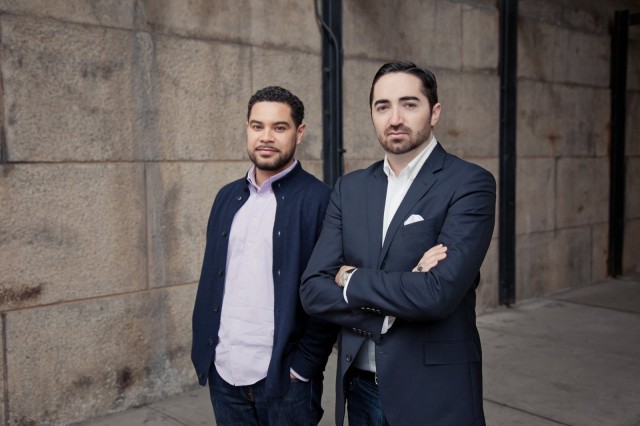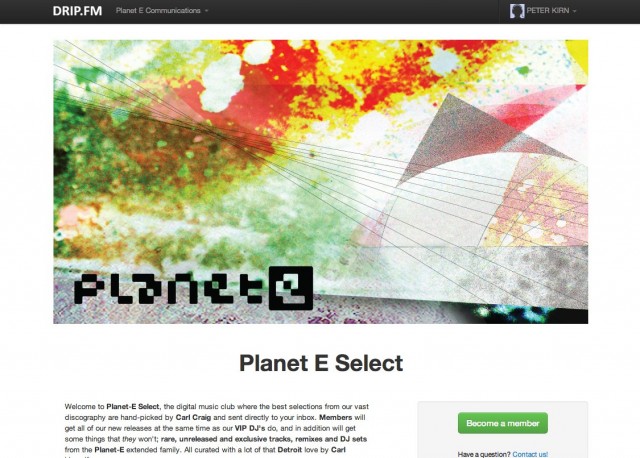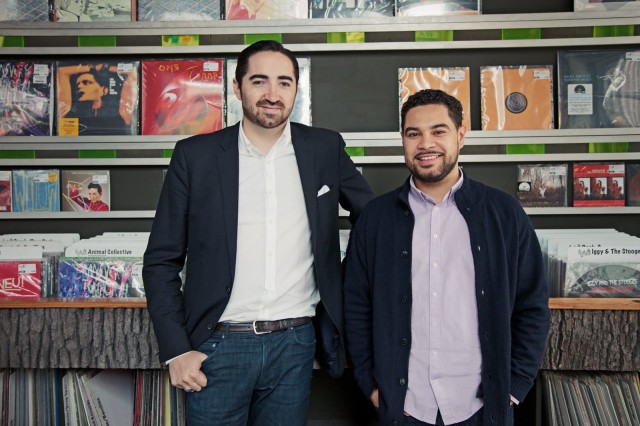
The record lives. Drip.fm co-founders Sam and Miguel merge subscription ease and affordability with high-quality downloads you keep, and even closer connections to artists and labels. Think “fan club,” not “utility company.” Here, Sam tells CDM how it came about. Photo: Will Calcutt.
PK: In the digital age, subscription services or “all-you-can-eat” music gives passionate listeners nothing if not flexibility and a wealth of music. But they can also distance music lovers from labels they care about – and the reliance on streaming threatens to sever the special relationship you have with albums that are really special.
Drip.fm is different. Founded by Ghostly International, it has the affordable monthly subscription rate – but with actual high-quality downloads you keep. First launched with some of Ghostly’s boutique-quality electronic music, it has since expanded to some big names.
Today could be a watershed moment for the service, with two new labels onboard. As Skrillex rides a wave of new dance music (or “bass music”) fans, his indie label project OWSLA is embracing the subscription model with their digital-only sub-label OWSLA. Alongside the OWSLA releases, they’ll be using the subscription service to distribute rare and unreleased remixes and edits. You get the lot for $12 a month, starting with two WAV compilations to get you started. Think “stuff you won’t hear on Spotify,” or “stuff you’ll hear on Spotify … but not until later.”
Billboard.com, for one, is taking notice:
Skrillex, OWSLA Label Announce The Nest: Subscription Service
Not a fan of Skrillex and friends? Turbo Recordings is also launching their content on the service. The Montreal-based label founded by Tiga is another boutique shop (see Resident Advisor profile) – just the kind of uniquely-focused music house (and house music) that would seem to fit the model perfectly. It’s the pricing of a big subscription service like Spotify, but with a narrow stream of music rather than “search for a slightly-incomplete catalog of everything.”
Oh, and vinyl lovers, the subscription model could matter to you, too: Drip.fm’s Ghostly channel is holding a vinyl sale today in honor of 12.12.12.
That’s the big picture. For the inside story, though, it’s best to turn to Ghostly’s founder for a view of why, at its heart, the service has more in common with a traditional fan service than generic all-you-can-eat music. It’s about fans rather than, say, cable TV subscribers.
It’s personally exciting for me to see where this has come, because it is an entirely DIY effort. Some music endeavors go out and get a bunch of venture funding and hire developers. Here, Drip.fm co-founder Miguel just sat with his laptop and started coding at the outset – I know, because Miguel and I were sitting working away in the same coffee shop – cum – karaoke bar in Manhattan last year and I got to watch over his shoulder. (I guess the coffee was working. And a lot of people probably just check Facebook. They’ve since grown from those beginnings.)
Interview: Sam
CDM’s Matt Earp was able to catch up with Sam Valenti IV, founder of Ghostly International, at the 11th San Francisco Music Tech conference at Hotel Kabuki in mid-October. He told us about the Drip.FM, the service founded by Ghostly that’s been around for a year and a half, giving us some insight into its genesis and where it might be going.
Can you give me the elevator pitch for what Drip.fm is?
Sure, we think of it as a way for fans to have access to premium content from labels they love.
The idea came from the fact that Ghostly, as a label, never had that missing link of a fan club. And we had a lot of fans saying to us “why can’t we just give you our credit card and have you send us stuff – just don’t make us work for it.” Which makes sense because the music industry is kind of stupid – we promote a bunch of stuff and then say “Here’s all this stuff! Now wait three months till you can get it.” Which is sort of backwards – when it finally comes out maybe you won’t even know that it’s out. So we wanted to build something that was really easy and fun and had perks and a sense of community where the super fan could get things for a monthly fee.
And it started with just the Ghostly label?
Yes, starting about 18 months ago (early 2011). And without even really trying, just by using Facebook and Twitter, we were getting people who wanted to join. After about 6 months we thought “OK, this is a real thing, let’s open it up”. And from that came the Drip.fm concept as it is today, where it can handle multiple subscriptions.
And then we went to the labels that we know, the labels that we love, and said “Hey, this thing is working for us, you should try it, there’s no risk, give it a shot.”
How many users were you at when you started approaching other labels?
Maybe a couple hundred. It wasn’t anything earthshaking but there was a lot of people who were getting excited about it, so we said “let’s just show this out”. Especially because as a label you could be involved without a significant amount of time invested – I mean on the product side it was a lot of time for us to build it but as a label it’s just uploading things, and enough labels were enthusiastic that we kept going with it. And we’ve added about one to two labels a month for the last 10 months.
Who are some of the other labels?
So December of 2011 we started with Dirtybird from San Francisco, then Stones Throw was January, and since then it’s been Fools Gold, Mad Decent, Domino, Morr Music, Luaka Bop, Now Again, Jagjaguwar, Dead Oceans, Polyvinyl, 6 Degrees, Planet E, and Wav.Pool – just a smattering of well-curated indies that have different perspectives. We didn’t want it to be a genre thing, it was more about who could tell a good story with their releases, who has a good catalog, and who was good at building fans.
Did you approach those labels or did any of them come to you?
Some came to us, some we went to them. We have a lot of labels who still want to get in but we’re still at the point where we want to make sure it’s a good service, that it’s working well, so we’re onboarding slowly. Because we don’t want to spend all our time answering customer service tickets, we want to focus on making a really good experience and then when we’re ready we’ll open up the doors a little wider.
Who built it and is someone now dedicated to running it full time?
We built it internally. Miguel [Senquiz], my cofounder, who’s the tech lead at Ghostly built the early prototype, and then we brought in an engineer to help rebuild the platform version we’re currently using. We’re trying to find a balance – the Ghostly team is a strong enough group that so far they’ve been able to put time into Drip without detracting from the Ghostly products because obviously that’s still a big part of our lives. But now we’re entering that next phase where it’s going to be a full-time team and my time gradient is going more towards Drip as well.
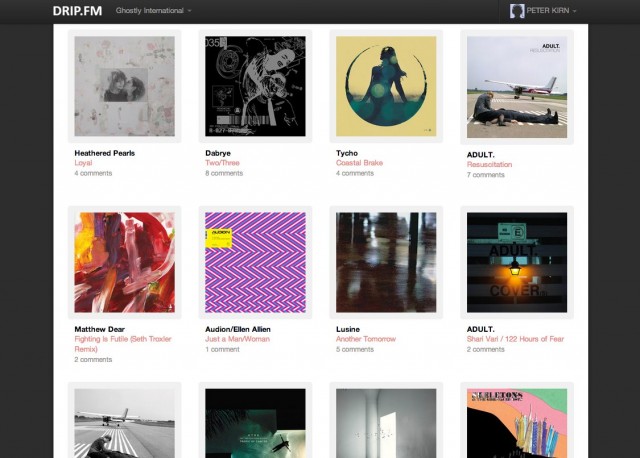
Pick a label you love, like Ghostly as seen here, and you get high-quality releases that focus on their artists and albums, including rarities. Download them as high-quality files.
Is it the same perks as you described for Ghostly for the other labels as well?
That’s actually a funny question because they’re almost hacking it to make it work for them – giving away concert tickets was one of the label’s ideas, doing Q&As and videos was another label’s idea. So they’re using the service as they want to use it, and that in turn is teaching us how we should be building it.
You’ve already become a platform.
Yeah, we want people to innovate and then tell us “Hey, it would be great if you could do this.” Which is another reason to keep it small for now, so that we can respond to those requests in a timely fashion.
[At this point a tweaker dude turns to us and says “Hey guys, can you do me a favor, I’m sorry to interrupt, I’ve got that machine open, I’m trying to buy a building … and I need to go upstairs, get this scanned and come back, so if someone sits at it, tell ‘em, you know, ‘don’t f***in’ touch it.’” Sam and I do our best to fend off the people that try to interfere with the transaction – which equaled 0.]
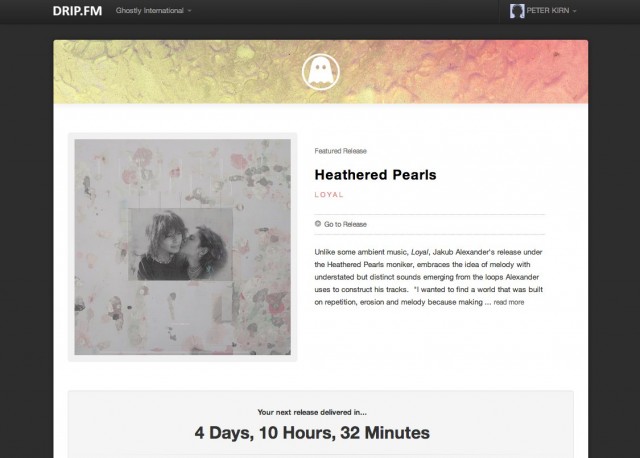
Significant releases and rarities are often left off of streaming services and online stores. Here, you get this fine new album by our friend Heathered Pearls – no loss in quality, no wait, no missing the music.
How do fans interact with the service – online, or through an app?
Just online for now.
Do you have plans to move into the mobile space?
I think so, but for right now instead of thinking about mobile we’re trying to think about what it is that Drip does for you and then from that figure out if it makes sense to do that on your mobile device. Trying to think of it more holistically – obviously mobile is where everybody is but right now we’re very download-centric, there’s a lot of DJs and audiophiles who like it because they can get high-quality files, so it’s more a question of “What does Drip want to be?” and what lends itself to mobile.
But it sounds like Drip itself is a big part of Ghostly now.
Yeah, it’s one of our revenue streams. Obviously iTunes and streaming is a huge part of the business, as is our web store and licensing. So it’s not like it will chip away at what we’re already doing. But what is nice about it is that building Drip is building a relationship with fans. More and more people are move into streaming businesses, which is obviously a good thing for fans, but we as a label are losing the ability to connect to them. It’s almost like once they’re off the grid they’re off the grid. So having them in the family through Drip we can hear from them, find out what they think and say “Check out this artist we just found.”
So for the Ghostly stuff, have you put tracks on there that aren’t actually signed to Ghostly?
Absolutely, because our schedule is already full but we still like a lot of music, and if the artists are cool with it we say “can we offer this as a Drip exclusive?” And the artists actually get paid for it as well [even if they’re not already signed to Ghostly]. We’ve even been leaned towards signing stuff that we put up on the service and then there was so much feedback from Drip that we were encourage to make a signing.
How many members in total now?
We’re not publishing that info yet because it’s still early days, but we’re really happy with how it’s going. Our hypothesis was that people will pay in advance, and that was kind of a wild notion, because everyone’s like “music’s free, it’s over” and I’m like “No, people will pay if it’s curated, if it’s a fan club and if it’s a concierge service in a way where you’re getting first look at a lot of cool stuff.” And so far it’s been successful.
Ed.: Ready to try it yourself? I have been for over a year on Ghostly’s catalog – and as a particular fan of a few Ghostly artists, it’s been something I’ve really loved using. Of course, having a label you want is key, but have a look below and let us know what you think. Still sticking to Spotify? iTunes? Beatport? Vinyl? The radio? Curious to know reader perspectives as artists and listeners. Thanks, Matt! -PK
For a hands-on with this service, our friend Barb Nerdy wrote over the summer about how Drip.fm works:
Drip.FM [sharing means caring]
